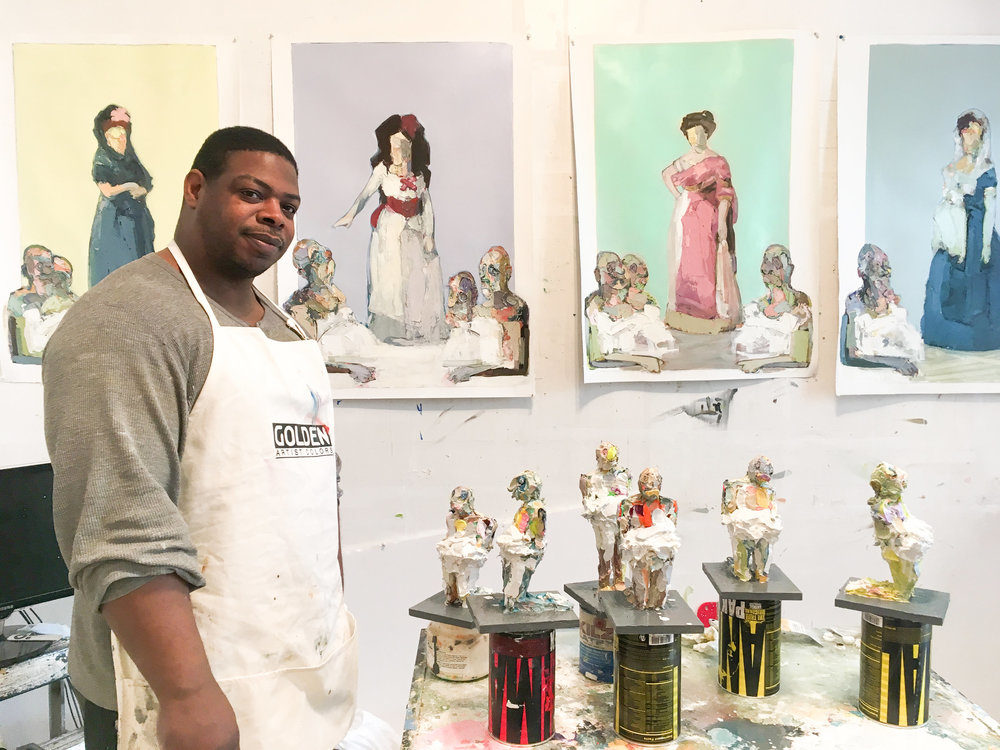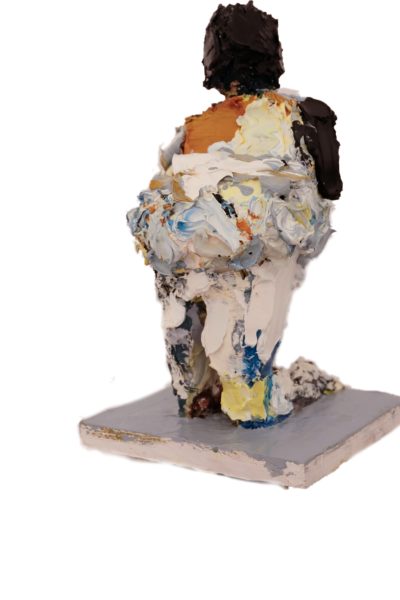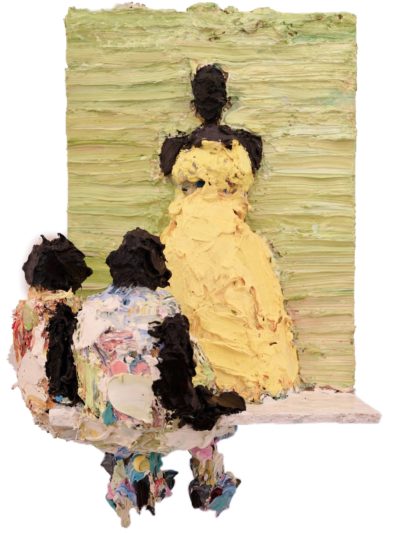Advertisement
Artist Lavaughan Jenkins Is Doing What He Loves And People Are Loving It Too

Nearly 15 years ago, Lavaughan Jenkins was on the brink of making it big as a painter. Fresh out of MassArt, he was offered a show at the now-defunct Judi Rotenberg Gallery on Newbury Street. People liked his work.
“I felt like I started making paintings to sell and not because I wanted to make them,” he reflects. “Not that they pushed it that way or anything, but that's what it felt like. It's just smart business to make what people want.”
Jenkins, though, wasn’t interested in churning out product to adorn the walls of the homes of eager clients. Painting, for him, was not a job (at least he didn’t want it to be) but a passion. So, he stopped painting.
“I stopped for six years,” says Jenkins, perched on a stool in his small Mission Hill studio. “I wasn't sure that I wanted to be a painter. And the business side of things was just really weird.”

Well, a lot has happened since Jenkins’ self-imposed hiatus from the art world. Now in his early 40s, Jenkins has since shown in galleries near and far, from Boston to Beijing. In 2016, he was named Emerging Artist of the Year at Boston’s Kingston Gallery. And in August, Jenkins will be one of four artists featured at the ICA’s 2019 James and Audrey Foster Prize, a biennial exhibition of work by talented Boston artists. (That show opens Aug. 21 and runs through Dec. 31.) Other prize winners include Rashin Fahandej, Josephine Halvorson and Helga Roht Poznanski. On the day that I speak with Jenkins, he is preparing for the ICA exhibit, surrounded by dozens of his pieces in his tiny studio.
It seems that Jenkins has found his footing again as an artist. But with a caveat: “Now it's on my terms,” he says of what he does. “I'm painting what I want to make and I'm just fortunate enough now that what I'm in love with, the art world is kind of liking it."

And at the moment, what Jenkins creates, the art world clamors for. Jenkins paints sculpture. Or, you might say, he sculpts paint. He creates energetic, gestural, “three-dimensional paintings” almost always figures, using traditional oil paint, but in a creamy cake-frosting impasto that recalls the works of painters Willem de Kooning or maybe Joan Mitchell. On the sculptural side, his work bears comparison to the painted sculptures of Manuel Neri.
South End gallery owner Abigail Ogilvy says his work “has profound expression” and is a “completely unique approach to contemporary oil painting.” Although he draws from art history sources and even fashion, she says, “in the end, the work is authentically just about Lavaughan.”
Ruth Erickson, curator of the Foster Prize exhibition, says that Jenkins explores painterly questions of form, color and light but through a “wholly original path.”
“The modifications Jenkins makes to his sculptures — from their poses to surface textures — lend them an incredible range of emotions,” she says. “Sitting or kneeling, with or without arms, alone or in a group, each one seems to express particular emotional or psychological states, especially in relationship to power dynamics.”
Up until a couple of years ago, Jenkins was doing more traditional two-dimensional work, oil on canvas or paper inspired by the lavish virtuoso style of Spanish painter Francisco Goya.
“As soon as I started thinking about it, I had a dream about Philip Guston,” says Jenkins. “And he came in this room and gave me a critique and told me it was time to go 3D. We were sitting here, smoking cigarettes. He gave me a really good talk about the work and told me I wasn't looking at his work enough. We're pretty similar in some ways… in terms of repetition of image, color. I've been looking at his color a lot and trying to carry his color over to my work, but also trying to make the 2019 version of his color, which ties into fashion because I'm a big fashion person.”
After his “talk” with Guston, Jenkins began to experiment with moving his work off the canvas.
“Basically, the next day I went to the art store and took half the money I made from work and just bought a ton of paint and material and started doing three-dimensional work.”

His first work was built of pure oil paint, heavy and expensive to make. But Jenkins discovered that he could create an armature of polystyrene foam and acrylic modeling paste on a wood base, saving on the cost of using just oil paint alone. With this structure underneath, he applies several layers of oil paint in a free tactile style that is built around sensuality and fleshiness. The result is work that is less about structure, the way a sculpture might be, and more about the application of paint to the surface, light and color. The pieces feel contemporary while remaining rooted in tradition. And that’s not by chance.
While Jenkins has been principally inspired by historic “masters,” ranging from Goya to some of the abstract expressionists and painters of the 1950s and ‘60s, he has also been inspired by a later generation of contemporary artists including Derrick Adams and Kerry James Marshall.
Jenkins says his work comes out of his own childhood and being forced to attend Sunday church service by his religious grandmother. Some of his figures stand in as his grandmother (“if I could paint hats, I would put some of them in Sunday hats — it’s going to happen,” he says) and some represent other people he has known and cared about, ranging from family members to romantic partners.
“These essentially are the people that raised me,” says Jenkins. “I could tell a story for each figure even if they're not specifically geared towards one person but the ideas that are behind them. These are the people who have impacted my life. And so, in a sense, they're that community, that village.”
When his work first went 3D, many of his figures didn’t have arms, but over time they have developed appendages reflecting a wide array of states of being. There is the hands-behind-your-head gesture known in communities of color where police officers reign with sadistic impunity, as well as hands held to the ears, as in wanting to block things out, or not hear things. There are hands held in prayer, and hands held wearily on the hips. Jenkins says he was looking at Goya’s painting “Third of May 1808,” commemorating Spanish resistance to Napoleon’s army in which a figure raises hands above the head before a firing squad, as he began to consider the role that arms would play in his work.
Although his figures draw from numerous sources, he wants to leave references loose enough to encourage “other people’s stories to get into it.” By the time his work goes home with a patron, he says, it should reflect not just his own memories but new ones brought by the viewer.
“They can take on other stories,” he says of his work. “That's a new narrative, a new memory that they get to hold."
The 2019 James and Audrey Foster Prize exhibition runs Aug. 21-Dec. 31 at the ICA.
